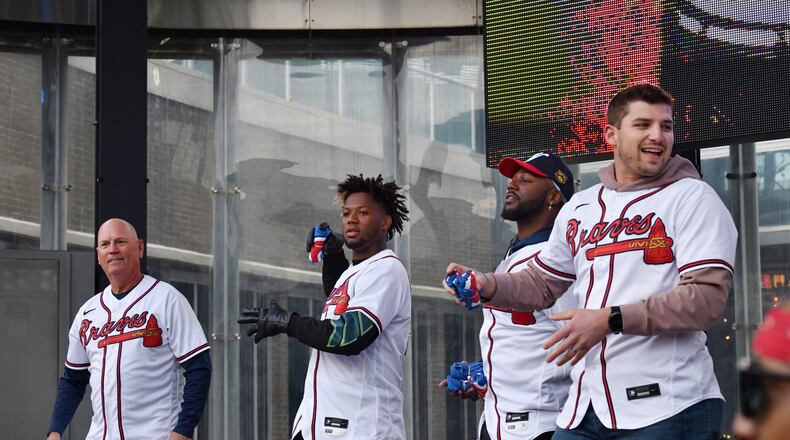The Braves have the largest payroll in franchise history entering the 2023 season. They expect their results to reflect that.
“I think this is the best team we’ve had,” Braves Chairman Terry McGuirk told The Atlanta Journal-Constitution on Tuesday. “And, you know, we won 101 games last season. I don’t know whether we’ll win 101 games again, because the division gets better, but it’s certainly a team that I think we’re going to be proud of.”
The Braves have become a behemoth. They’re coming off five consecutive division titles and a World Series championship in 2021. And they know maintaining this success means investing in their core players.
McGuirk told the AJC at the end of last season that his goal was for the franchise to soon carry a top-five payroll. Liberty Media President and CEO Greg Maffei echoed the same thought in November, saying he expects the franchise to reach such heights. The Braves aren’t yet to that level, but their spending has continued ascending – and they’re set to pay the luxury tax for the first time under Liberty Media’s ownership.
The Braves enter the 2023 season with a payroll of roughly $199 million, according to Roster Resource. That ranks No. 8 among teams, right behind the Blue Jays and the Angels (both $212M) and ahead of the Rangers ($198M), Atros ($193M) and Red Sox ($193M), by the same source’s data.
A different number is used for luxury tax purposes. The Braves’ Competitive Balance Tax figure is calculated around $240M, per the same site, which exceeds the first luxury-tax threshold of $233 million. As a first-time taxpayer, the team would pay 20% on overages. The Braves are currently seventh in CBT payroll, a result of their many long-term extensions with younger players orchestrated by President of Baseball Operations Alex Anthopoulos (whom McGuirk has called baseball’s best executive). The CBT number is the result of the average annual value of each contract on the 40-man roster plus additional benefits. The final figure is calculated at season’s end.
The Braves join the Dodgers ($245M) and Blue Jays ($250M) as current first-level taxpayers. There are four thresholds, each carrying sharper financial penalties for exceeding. The Braves are still comfortably below the second threshold at $253 million, and they’ve indicated there are no financial limitations right now should the right opportunity come along.
“We’re getting a bit of a penalty for making these long-term commitments, but it’s what is the right thing to do for the franchise,” McGuirk said. “Obviously, it’s a tremendous thing for the franchise, and it’s a small price to pay to put together this kind of an organization and this group of players.”
The payroll is expected to keep climbing. Put in the simplest terms, Truist Park, The Battery and the team’s success have been great for business. Earlier this month, Liberty Media released 2022 financials that revealed the Braves had franchise-record revenues of $588 million. The team expects similar success in 2023. The days of fans opining the Braves weren’t spending to their full capabilities are long gone.
“We put together this environment, this campus, The Battery, the ballpark, we approached this business all with trying to grow payroll in mind,” Braves CEO and President Derek Schiller told the AJC. “Everything we’re trying to do here is develop the business to support an ever-growing payroll. So I think what you’re seeing is proof of that. Obviously, the business right now is really good. We cut off season tickets for the first time. Last year, we had record attendance. We’re expecting that we’re going to be at or above that this year.
“For all intents and purposes, the business has never been healthier. As a result, payroll has never been healthier.
“The baseball side of our business, Alex and his whole team have a great deal of confidence on any given year that we’re going to have a strong business to support and sustain what is happening. So this really works because all of us are doing our part together. We just build upon the confidence and level of expectation that we each have on each other.”
McGuirk on the same subject: “It’s this virtuous circle of everybody contributing. It’s very satisfying to reward the fans and to see them as elated as we are about the success. As we look at the coming year, we sold 94% of the tickets last year, and we’re going to do better this year. There is no other team in baseball that is doing this kind of business. It’s all on the fans. The fans are providing the support that enables us to really put the pedal to the metal to try and drive this team to World Series performances.”
The Braves made only one headline-grabbing acquisition this winter, trading for catcher Sean Murphy. It was their second major trade with Oakland in two years after executing the Matt Olson deal last spring. Like Olson, the team promptly signed Murphy to an extension, this one worth $73 million over six years (he’ll make $4 million this season).
Beyond Murphy, the team’s additions were modest. The Braves were quiet in free agency, signing just relievers Nick Anderson ($875k while in the majors) and Jackson Stephens ($740k while in majors), and outfielder Jordan Luplow ($1.4 million). In trades, they added relievers Joe Jimenez and Lucas Luetge, and outfielders Sam Hilliard and Eli White for depth.
“As I said, we’ve always felt in recent times, we could be a top five payroll at any moment,” McGuirk said. “If there was a deal that made sense for the team to improve itself dramatically, we would do it. And as you know, there’s just not many openings in our organization for somebody from the outside. And frankly, that free agent market comes on like lightning and is over pretty quickly. The players that might fit with us are usually gone pretty quickly.”
All-Star shortstop Dansby Swanson departed in free agency for the Cubs, who signed him to a seven-year, $177 million contract. The Braves didn’t view Swanson as that caliber of player. Thus, the franchise experienced a notable exit for the second consecutive offseason, following first baseman Freddie Freeman signing with the Dodgers last spring.
Swanson and Freeman (six years, $162 million) would both be the highest-paid Braves on the roster. Their contract’s average annual value – around $25 million for Swanson and $27 million for Freeman – would also be the biggest on the Braves’ books moving forward. Swanson’s replacement, at least to start the season, is Orlando Arcia, who makes $1.3 million. Youngsters Vaughn Grissom and Braden Shewmake, who could eventually get opportunities, will both make the minimum.
While the Braves have provided MLB a new blueprint in signing promising youth to long-term deals, it’s notable that none of those contracts individually are consuming a significant portion of payroll (at least comparable to your typical pricey free-agent acquisition). This season, Olson is the highest-paid Brave at $21 million, earning $1 million more than veteran starter Charlie Morton.
Outfielders Marcell Ozuna ($18 million) and Ronald Acuna ($17 million), closer Raisel Iglesias ($16 million), third baseman Austin Riley ($15 million) and starter Max Fried ($13.5 million) are the club’s other players making eight figures this season. These seven individuals cover $120.5 million of the team’s 2023 commitments (around 62% of payroll).
In other words, this season will continue the Braves’ trend of spreading their wealth. Of the six National League teams that qualified for the postseason last October, the Braves were the only one without a player whose salary exceeded $20 million (Morton earned that number).
Four of the other five NL postseason clubs had at least one player earning over $30 million. The Phillies were the exception, with Bryce Harper their top earner at just over $27 million (his AAV is lower with the money spread across a 13-year contract through 2031). The Phillies then used their financial might to sign shortstop Trea Turner to a massive deal over the winter in which he’ll also make just over $27 million each year through 2033.
For comparison, the Braves have two deals that run past 2030: Riley’s ($22 million each year from 2030-2032, with a $20 million club option for 2033) and Harris’ ($12 million in 2030 with two ensuing club options worth $15 million and 20 million, respectively). Olson also has a $20 million team option for 2030.
The Mets spent over $423 million on free agents this winter, largely to retain the team they had. The Phillies spent just under $400 million to bolster their National League pennant-winning club. The Braves spent around $3 million on free agents.
Therein lies a strategic difference with the Braves versus other wealthier clubs. The franchise prioritizes development and early extensions that cover much of a player’s prime years, rather than bidding for a player in his prime age on the open market. Those situations drive prices up, and the Braves are having success without entering bidding wars like the Phillies, Mets and others.
The Braves’ approach has worked thus far. Once again, they enter the season division favorites.
“All of the analytical groups that are looking, as we start the season this week, at who’s going to win the most games, the highest percentage of getting into the playoffs, the highest percentage of getting to the World Series – whether it’s Baseball America, ZiPS, FanGraphs, whatever it is – every one of them picks the Braves to win the National League East,” McGuirk said. “I mean, that is very high praise for a team that is being outspent pretty dramatically by the Mets and Phillies. So we’ve obviously done a better job with less money to pick the players who are going to play for the Atlanta Braves, as evidenced by all of these measurements.
“You have to go out and play. You have to do it. I think our players have proven that they are that quality and can do it. And with Snit (manager Brian Snitker) and his coaching staff, the leadership, it all just continues to (come together).”
About the Author
Keep Reading
The Latest
Featured



